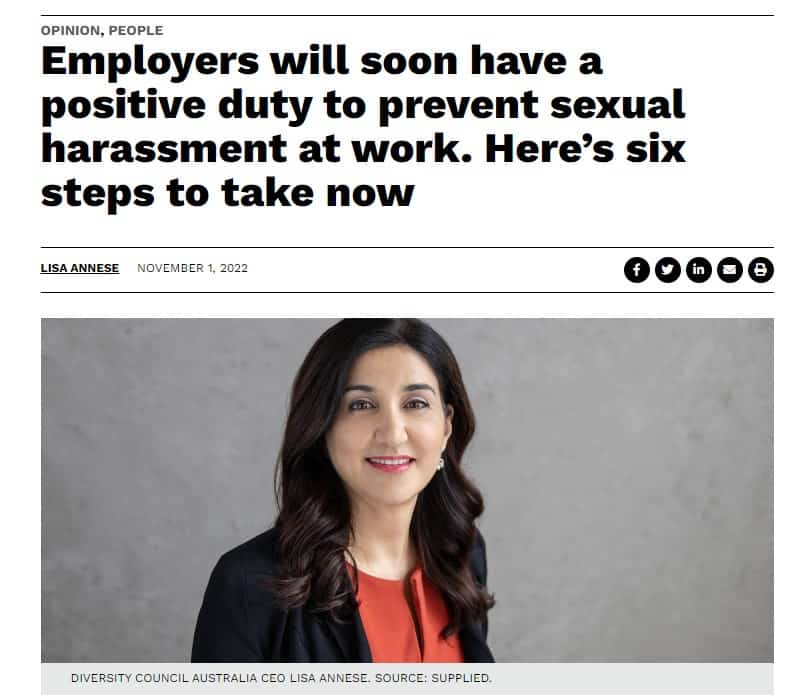Lisa Annese‘s article is interesting but, as with many articles on sexual harassment at work, only goes so far. It is discussive rather than practical, even though it seems to promote action. Sometimes the actions are not clear enough to inspire change. Below are my thoughts on the six steps to complement Lisa’s recommendations.
1. Recognise the continuum of sexual harm
Call out disrespect at all levels of the organisation and discipline those speaking it. It may not all relate to sexual harassment, but it will have a general positive benefit on your workplace culture
2. Focus on gender equality
I find it amazing that women continue to be paid less than men. But equality is more than money and includes opportunity and support. Examine how the organisation and its management structures and processes were designed. Don’t just restructure the management lines and job roles, restructure how basic business decisions are made, who is consulted and who decides.
Also always investigate the reasons for the existing inequality. Decide whether it is a (unavoidable?) social consequence or a consequence of how the business was designed and the aims of the business.
3. Build a respectful workplace culture
Values-building programs are okay but are wasted if the business is not redesigned to integrate respect in everything it does (see both points above). Any workplace values or culture must also recognise that companies must generate profits. The challenge is to ensure that profit is not based on exploitation of workers and/or customers.
4. Focus on building inclusion at work
Inclusion should have been a consequence of the investigations of and response to workplace bullying incidents late last Century. It is the opposite of the active exclusion that bullying often represents. It is not possible to bold inclusion without an active program of respect (see above).
It is also very difficult to retrofit inclusion to a workplace without substantial, but manageable disruption to the business. Much better to design businesses to include inclusion (confusing alliteration intended). Accept the disruption as the business will become more sustainable.
5. Focus on HR processes and practices
YES, because if your workers have experienced sexual harassment at work over the last ten to twenty years, the Human Resources strategies have failed. HR should focus prominently in any reevaluation of your business management.
Also, because HR has likely failed, read, discuss and consult on the free and practical guidance on preventing and managing sexual harassment and psychosocial hazards provided by the occupational health and safety regulators in your jurisdiction. Talk with your work health and safety (WHS) advisers.
6. Focus on accountability
As in step 1, do not be afraid to discipline your staff if they are disrespectful and harassing staff. Sure, go through the re-education process, but do not be afraid to sack unsalvageable perpetrators. You are likely to find that your staff will heave a collective sigh of relief with the perpetrator gone and that a new respectful workplace culture is likely to result.
Lisa Annese writes that many companies are being proactive on the management of sexual harassment, but in my experience, few are sufficiently active on preventing sexual harassment, even though this was a major theme of Kate Jenkins’ world-first inquiries.
It is important for businesses to go beyond the polite limitations on sexual harassment in the workplace over the past twenty years or so. There are definitely issues of natural justice in some of the discussion above, but natural justice does not mean that a hazard, such as an offensive and toxic worker or manager, must be retained. Work health and safety obligations would say that the hazard should be eliminated from the workplace, as a starting point. This consideration should not be glossed over or excused. Removal of the sexual harassment hazard can be supported and justified through the WHS processes.


Thanks Howard.
A very useful and insightful article, KJ: we suggested to the Commissioner that workplace-related Sexual Harassment and Bullying are better treated as Misconduct, rather than as ‘personal conflict’ ( – which opens the door to inappropriate use of Mediation). The Respect@Work report takes this view, I was delighted to see.
So we strongly endorse the article’s points #1, #5, and #6 in particular: hopefully the new ‘positive duty’ on employers will drive meaningful change. And we have developed a comprehensive evidence-based toolkit [on a 16Gb USB drive] to help individuals with that.
HW